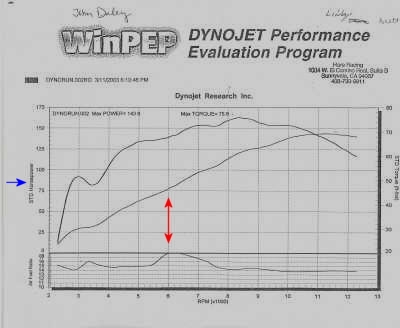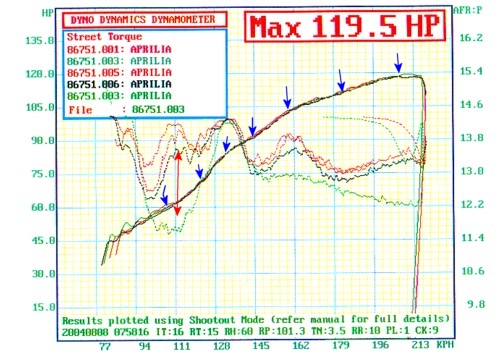
What to ask -

This dyno chart shows an "A/F Ratio"
of 18:1 at 5900 to 6400.
The horse power curve, though, is in line with the power that it made at richer
"A/F Ratios" above and below -
The questions are:
How can it make good power at 18:1 A/F Ratio?
If it was really 18:1, how can it still run? (engines at full throttle tend to "not
run" if the A/F is really 18:1).
If you change it to a "correct" A/F Ratio, will it make more power? - as it seems
to be making OK power at 18:1...
Diagnosis:
Using a "wideband" O2 sensor often produces incorrect and misleading data.

Description: Aprilia 1000
Subject: A/F Ratio from wideband 02 sensor
#1 This chart shows 3 different chips and wildly varying "A/F Ratios" at 111...
But the HP at 111kph is amazingly...... the same.......
Diagnosis
The reported A/F Ratio cannot be correct as there are 3 different
values - all producing the same power.
But most upper level tuners know that.

Description: Aprilia 1000
Subject: Sweep Tests
This chart shows 3 different chips and, for all intents and purposes, the same power readings.
Diagnosis
Each of these chips has pretty much different main fuel
and ignition maps, but retain similar acc. maps -
I think that the dyno is allowing the engine to acc. so quickly that it's triggering
the very similar acc. maps and not actually reporting what the engine would actually
be delivering if in the real world, as in acceleration on the freeway / parkway
/ autobahn or your favorite secret road.... where the bike would be using the Main
Fuel Maps (and just "trimming" with Acc. Maps - not relying on them, wholly).
Solution
Measure power under load in a Steady State Test - not in a Sweep Test.

Aside from the weird A/F Ratio graph.....
"STD HP"??
What's that on the left side of the graph?
(it actually means "uncorrected to std air conditions")
Diagnosis:
To properly compare power between different CALIBRATED dynos, all hp must be corrected to "standard air" temps, pressures and humidities.
There are a few different "correction factors" and a common one is similar to aviation "standard air" i.e. 0% humidity, 59f/15c and 29.92" in barometer.
In the US, we generally use "SAE" correction factors and in Europe... they use DIN correction factors.
This chart was given to a customer after the shop worked on the
bike and whatever they did - didn't make more power.... So...... they printed out
an "uncorrected" chart that the dyno company calls "STD" for some reason. One might
assume that STD would be STD corrected"... but... it's not.....
If you added in the proper correction factors, the bike made 3-4 hp less "corrected"
to SAE correction factors and they didn't want to show that to the poor customer
- They should have figured out what happened and caused the loss in power and fixed
it......
All magazine tests that I've ever seen and all technical work is "Corrected".
As far as the "wideband o2 sensor generated af ratio - I'd bet you $100 that if they richened up that 18:1 area to 13.1:1 - the bike would lose power in that area (that's a "sucker bet" - don't do it!!)
Incidentally - this bike - according to the 4 Gas EGA on an EC997
dyno, when we later tested it, indicated that it was a teeny bit rich, overall,
and power came back up, somewhat, when leaned out a bit with the TEKA SFI. There
was no indication of that massive lean spot as shown by a wideband o2 sensor dynojet
af ratio.
Hint: 4 Gas EGA is awesome tuning equipment!